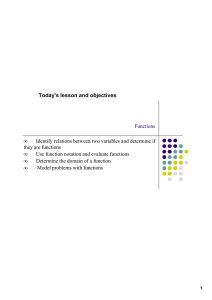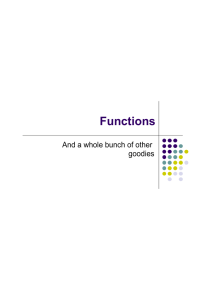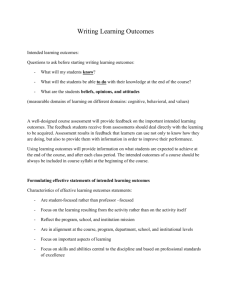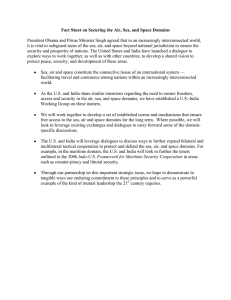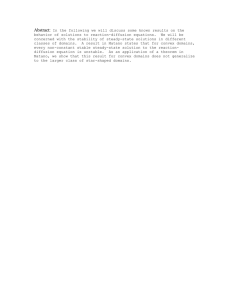UbiquitousArchive 4
advertisement
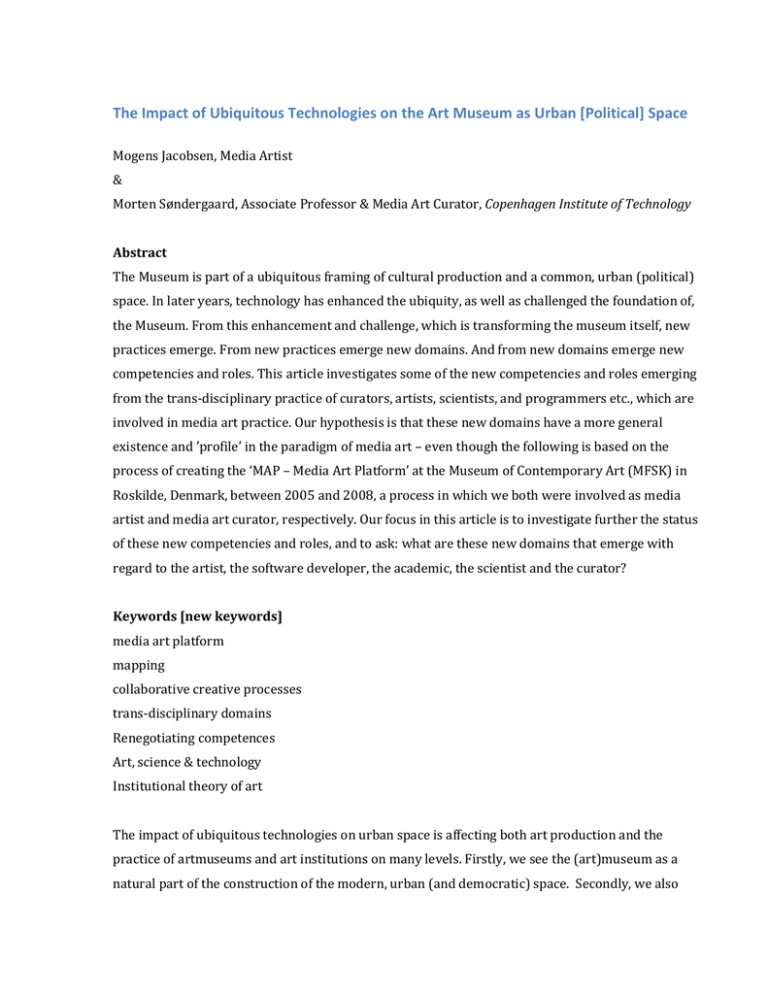
The Impact of Ubiquitous Technologies on the Art Museum as Urban [Political] Space Mogens Jacobsen, Media Artist & Morten Søndergaard, Associate Professor & Media Art Curator, Copenhagen Institute of Technology Abstract The Museum is part of a ubiquitous framing of cultural production and a common, urban (political) space. In later years, technology has enhanced the ubiquity, as well as challenged the foundation of, the Museum. From this enhancement and challenge, which is transforming the museum itself, new practices emerge. From new practices emerge new domains. And from new domains emerge new competencies and roles. This article investigates some of the new competencies and roles emerging from the trans-disciplinary practice of curators, artists, scientists, and programmers etc., which are involved in media art practice. Our hypothesis is that these new domains have a more general existence and ’profile’ in the paradigm of media art – even though the following is based on the process of creating the ‘MAP – Media Art Platform’ at the Museum of Contemporary Art (MFSK) in Roskilde, Denmark, between 2005 and 2008, a process in which we both were involved as media artist and media art curator, respectively. Our focus in this article is to investigate further the status of these new competencies and roles, and to ask: what are these new domains that emerge with regard to the artist, the software developer, the academic, the scientist and the curator? Keywords [new keywords] media art platform mapping collaborative creative processes trans-disciplinary domains Renegotiating competences Art, science & technology Institutional theory of art The impact of ubiquitous technologies on urban space is affecting both art production and the practice of artmuseums and art institutions on many levels. Firstly, we see the (art)museum as a natural part of the construction of the modern, urban (and democratic) space. Secondly, we also recognize the loss, historically, of influence by artmuseums on the construction of the new cultural spaces that are adequately measuring up to the emergence of commercial media culture generally and New Medias impact on art specifically. A city could be said to exist at two levels: A lower level (buildings and streets), and a macro-level (the Urban). However, what is going on in the city, the life and practices, as well as a production of relations and value, takes place in between those two levels. … at the sharp end is the population, for which one could attempt the production of an appropriated space… (Lefebvre) According to Henri Lefebvre, the interference of the Urban into the lower level of the city is a central mechanism in the transformation of a public space into a social space. It is at this sharp end, that the production of a space that can be populated and lived in takes place. To exclude the urban from groups, classes, individuals, is also to exclude them from civilization, if from not society itself… (Lefebvre) We may ask, then: Do art museums participate in this production of cultural and social spaces? Historically, they are essential in that production because they help infuse art and artistic processes into that process in which a relational and social space; a space in-between where interaction may take place. Developments in mediated culture, where ubiquitous computing is only the latest phase of an evolution of communicative and interactive elements in our sociatal set-up (Meyrowitz, 1985), changes the role of art in the museum as well as the role of the museum for the arts. We call this transformation ‘the expanding democratic space’. According to Rosalind Deutsche, the critical change happens in the concept of public space itself and in such a way that art, to be part of a public space, has to be a public space itself. It is a play of identity and roles – or, in the words of Joshua Meyrowitz – a matter of negotiating the ‘impact of electronic media on social behaviour’ (Meyrowitz, 1986). The introduction of the concept of the public space into art criticism shatters mainstream categorizations of public art … the public sphere excavates other distinctions that, neutralized by prevailing definitions of public space, are crucial to democratic practice. Art that is “public” participates in, or creates a political space and is itself a space where we assume political identities. (Deutsche) We will propose that the function of art as a space where we assume political identities in fact is a formulation of the impact of ubiquitous media on social behaviour. Let us call it ubiquitous cultural production – or “ubicult” - for short. Sociologically, ubiquitous computing may mean the decline of the computer addict. In the 1910's and 1920's many people "hacked" on crystal sets to take advantage of the new high tech world of radio. Now crystal-and-cat's whisker receivers are rare, because radios are ubiquitous. In addition, embodied virtuality will bring computers to the presidents of industries and countries for nearly the first time. Computer access will penetrate all groups in society. (Mark Weiser, 1991) Ubiquitous cultural production, then, is activating the public space, making it a political space where an exchange of ideas takes place – but also the place where the appropriate way of life and behaviour is negotiated, constantly. The public space… is the social space where, in the absence of a foundation, the meaning and the unity of the social is negotiated – at once constituted and put at risk. What is recognized in public space is the legitimacy of debate about what is legitimate and what is illegitimate. (Deutsche) This is where, in our view, art institutions and the art museums, re-enters the scene – as a place where a renegotiation the political identity of the ubiquitous cultural production takes place. The expanding democratic space demands an expanded notion of art and art institutions (and vice versa). In the public space, before it becomes a social space – which, incidentally, may only occur on rare and short-lived occasions – art and art institutions have to negotiate with a wide range of players that are not necessarily interested in art (or have time for art) at all. This may explain the focus by certain neo-liberal politicians upon Canonized Culture and Cultural Enheritance, because if you define the identity of cultural space, you define the political identity of the public sphere. Ubiquitous cultural production is followed by a emergent new awareness (and practice) by museums – which is directed partly towards finding its (critical) place in the ubiquitous (and highly commercialized) media culture, partly towards reclaiming its role as gatekeeper in the defintion of the quality and genealogy of ubiquitous culture. In a sense, it could be seen as a battleground of cultural signification that invites confrontations and struggles – and, thus, in the very definition of LeFebvre, places the museum and art institutions at the centre of the construction of a ubiquitous public space. The right to the city … signifies the constitution or reconstitution of a spatial-temporal unit, of a gathering together instead of a fragmentation. It does not abolish confrontations and struggles. On the contrary! (Lefebvre) But all this is mere theory – our concern is how this ubiquitous cultural production manifests itself in practice? – in the words of artist Walter Riedweg: For me, it’s a question of choosing … I’m not interested in power, but in conversation. In this sense, it is a political question, one that has nothing to do with everyday politics but rather with the way we establish our presence in the world. (Dias) ... and more in this vein: …our manner of working consisted precisely of detaching ourselves, little by little, from the artistic field […] There is the experimental side, but there is, above all, a method, a collective aesthetic exercise. We try to speak not of social function but of an encounter with the other, an encounter with a collective sensibility. (Dias) Our premise is, that from new practices emerge new domains. And from new domains emerge new practices, competencies and roles. This paper investigates some of the new aspects, functions and disciplines emerging from the trans-disciplinary practices of curators, artists, scientists, and programmers etc., who are involved in the renegotiation of the museum in the expanding democratic space of urban ubiquitous culture. Our hypothesis is that these new domains have a more general existence and ’profile’ in the paradigm of ubiquitous cultural production – even though the following is based on our experiences during the creation of the ‘MAP – Media Art Platform’ at the Museum of Contemporary Art in Roskilde, Denmark. This project took place between 2005 and 2008 and we were both involved, as media artist and media art curator, respectively. The focus of this article is to investigate further the status of these new competencies and roles, and to ask: what are these new domains that emerge with regard to the artist, the software developer, the academic, the scientist and the curator? Initially, we had an idea that these roles could be mapped onto a fairly simplified 'typology' in order to define the transformation and the characteristics of the new domains that emerge. We do not have any doubt about the new domains emerging – in fact, we believe that many of the media art domains have been dominant on the art scene for decades. What we question is the status of these 'new' domains, and what they tell us about the constitution of roles in the art system. As expected, it has been necessary to make harsh reductions in the roles and profiles, as well as in the selection of domains. It should also be stressed that – to simplify things - our model works with ‘roles’ and not individuals. We acknowledge that any individual may possess a multitude of competences and roles. We acknowledge that relevant writings are being authored outside the academic world and artists are trained outside the fine art academies. Thus, our typology of domains and the mapping of competencies and roles within these domains are not anywhere near being 'all inclusive'. But, then again, not much in 'real life' is... To begin with we needed a typology based on 'traditional' roles and their domains… and came up with the following model. Figure 1: The domains of New Practices. Some comments are needed here about the selections of domains and the roles we have ascribed to them. First, the roles present in this model were the official ‘titles’ of the active members of the Media Art Platform (MAP) team (at least, to begin with). Second, we have attributed each with two concepts – i.e. the artist with autonomy and aesthetics. These are not categories but rather, in our thinking, ‘major challenge’ of this particular domain. The practice conducted in the ‘art’ domain is striving towards achieving autonomy and aesthetics – perhaps without achieving it, and certainly without making claims to any exclusivity: both autonomy and aesthetics may be part of other practices, and other attributes are part of the art domain as well; only, we claim, not as a ‘main challenge’. Third, this way of ‘describing’ the traditional domains is also a mapping of knowledge – and a metaphorical re-use of the principles of conceptual integration theory, with a twist. (Lakoff & Johnson, 1999) It could be viewed, strangely, as a way of conducting archaeology of knowledge with the methods of cognitive linguists. The point of all this is that, as it turned out, these domains were not practical or even present in the process and actual making of the MAP project. The creative processes and practices of the transdisciplinary collaborative team that created MAP also broke down the original individual roles of the group members. Thus, MAP was in fact a MAPPING of THE DOMAINS OF MEDIA ART PRACTICES. Let us then, in order to find out what replaced those domains, turn briefly to the MAP project – and what actually happened in the creative transformation of roles. A trans-disciplinary setting A number of rather interesting and important perspectives arose in the process – and from the collaborative viewpoint – which point towards what Peter Weibel describes as the trans-disciplinary setting of contemporary art (Weibel 2004). This trans-disciplinary setting began with an artist and a curator - the two of us - agreeing on investigating further the possibilities of making a platform for media art – and thereby reactivating the content of the archive consisting of both historic and newer media art forms. This team worked for the first part of the project – between 2005 and 2006 – eventually producing the pilot ‘test-case’ of MAP: The Hørbar (Søndergaard & Jacobsen 2009). This paved the way for the expanded MAP project, which took place in 2006–2008 and included a larger group of around nine persons of different competencies. The result was presented at the exhibition TOTAL_ACTION at MFSK during October–December 2008. When we selected the participants of the MAP group we knew that the primary task would be like solving, what Horst Rittel and Melvin Webber called a ‘wicked problem’: There could never be a true or false solution to the problems facing the group; and the solutions we chose could not be based on previous cases, since we could not locate records of any similar projects (this was in 2006). And we did not have, or want, a ‘stopping rule’. We had to reach some sort of consensus within a specific time frame, as we had already planned the opening date for the exhibition. The group included several members who were used to working with diverse methods of innovation workshops. On account of the trans-disciplinary professional character of the group, we had hoped that the group would be self-sustaining and self-directing once it was initiated. The objective is not the postmodern death of the author, but rather the transformation of the concept of the author from individual to multiple authorships, into collectives, communes and transdisciplinary ways of working (Weibel, 2004) But the real ‘content’ of this collaboration was not really the ‘result’ but rather because of a number of factors that are now materializing as very real contexts for cultural production of any kind: The trans-disciplinary condition The cognitivity of the collaborate process The challenge to traditional forms of knowledge by New Media and Historical Media Art. The challenge to the traditional forms of ’competencies’ – some of which are almost mythologically present in our society. Take the notion of the ‘artist’, for instance. This is still surrounded by the idea of the almost romantic nature of one creative subject expressing him or herself. Take the notion of the curator, or the technician or the designer – and you will have similar mythologies that we seldom address in their formative discourse. But the idea of the one creative subject creating meaning and content for everyone is antiquated on so many levels that it is rather surprising that it has not disappeared altogether. Why is this so? Why do we maintain traditional roles of competencies when evidence of much more effective and promising forms of creativity is clearly visible all around? The answer is perhaps that we are creatures of habit. But, more poignantly, another answer is that there is a system of power associated with those roles that are difficult to break down – being metamythologically interwoven with our cultural and political fabric of production of meaning. We propose that it is possible to follow the transformation of domains from the basic representations of competencies that are sketched out in the diagram above, and to see these as parts of a cognitive mapping of the traditional cultural field into new domain(s). We played a little game of cross-matching the profiles of the traditional domains with each other, coming up with the following 10 new ‘typological’ domains: Figure: Mapping of competences in the transdisciplinary domain We think it is possible to use the elements of the mappings of the cognitive processes of conceptual integration to diagrammatically represent what is taking place in the formation of the new domain. But we want to envision this as an ongoing process that is not irreversible, but indeed shows strong tendencies to ‘roll back’ – the traditional competencies of the artist have obviously not disappeared, for instance. But the roles are re-negotiated, and are thus transforming through the effects of the new domain. One of the big tasks would be, then, to figure out – or observe – which categories are ‘inside’ this new domain – and to name them, obviously, is not an easy task. There could be some help to get in the very formation of the new domains – we observed some interesting points, at least. Let us take a look at some of them. First, the new domains are collaborative domains – a place for inter-subjective (and inter-objective) action. Second, they are founded in processuality and a ‘cyclic visual thinking’ (Søndergaard 2010). Third, they transform creatively the professional roles of the participants, but do not annul the ‘original’ competencies. Rather, they receive a new outlook or profile, in the process. Our cross-mapping of traditional domains brought out a number of domains already in existence and well established, as well as several under creation: 1. An already established domain. The curating artist and/or the curator superstar of the 1990s. 2. A domain being established at universities around the world. The artist academic, e.g. the doctoral artist. 3. A domain being established internationally: Art and science (re)discovered as an valid field of exploration. Another example is the current focus on massive data visualization as an artistic field. 4. Artists working within the field of software art 5. Software+Curator: Still a rare bird, but perhaps a field being established at the moment. One example could be curatorial decisions behind the seminal exhibition ‘CODeDOC’ at the Whitney Museum. 6. Software+Scientist: The computer scientist? 7. Software+ Academic: Humanistic Informatics. 8. Scientist+Curator: The new collaboration between science museums and artists. 9. Scientist+Academic: A tautology. 10. Academic+Curator: A role already well established. As mentioned above, the profiles of these new domains are the really interesting part of this mapping. What does the art curator inherit, for instance? Before we enter this final, but by no means conclusive, part of our article, we discuss some of the theoretical framing of trans-disciplinary mapping. The multiplication of challenges… …for all we know, it may be that human creativity has dried up, and that in the future it will be the nonhuman world which squirms out of our conceptual net. It might be the case that all future human societies will be (as a result, perhaps, of ubiquitous technocratic totalitarianism) humdrum variations on our own. (Rorty 1979: 351) This might be one of the most significant propositions ever made about creativity since it foretells the situation in which we are engaging in – the hybrid art/technology situations in the expanded digital field. The transformation of creativity might not be an innovative process, but instead, indeed, a reproduction of the idea of creativity as human activity. The slightly dystopian overtone in the quote by Richard Rorty should not, however, be seen as a representation of the undergang – of some sort of ‘intellectual’ decline of transformative creativity to mere repetition (although on different levels). Our investigation is fed by the idea that cultural and societal transformation through creativity is possible in the expanded digital field of artistic production. Therefore, we will begin by introducing the idea of transformative creativity. The idea that art may, can, will or should transform ‘society’ is not a new one. Some would call it idealism – or an ideology, even – to have anything outside the market economy create transformation. But changes over the last decade, in the cultural constitution of the world’s global culture and economy, have altered the attitude towards art and creativity. We are realizing, again, that the vision of the market economy is too limited when it comes to cultural production and creativity. The art-is-transformation metaphor is a strong driving force in the creative development of new ideas in the growing alternative culture of trans-disciplinary domain exchange. Art, in this instance, is practice, the facilitator of movements across domains and the dialogue between different fields of competencies. It is also the implementer of new aesthetic paradigms. There are some good examples from the art world, but indeed very few where society – if not transformed – moved in a new direction. The question we raise here is what is the status of ‘transformation’ as an artistic form of practice? What, indeed, do we understand by ‘transformative creativity’ today? It is possible to identify three trends of transformative creativity that were (and still are) active in the formation of modernity and the modern society: The rationalistic (bourgeois) trend focusing on growth and progress of technologies of (re)production and pleasure; the subjective (protestant) trend focusing on the emphatic now and the creation of the individual experience; the aesthetic (formalistic) trend, focusing on existence transcending time and space and the creation of the radical ‘new’. The question is: does transformative creativity today offer something new? Are participatory practices brought on by digital technologies inside or outside the complex of modernity? By analysing the domains of the new trans-disciplinary paradigm we work from the fundamental insight that the modernistic trends of transformative creativity and creative production have changed dramatically. Instead of a division of (often) opposing trends, today technologies are all part of a trans-disciplinary field, which we will call the expanded digital field. The expanded digital field encompasses transformation of societal, cultural, political and individual creativity. Instead of discussing art and media as separate entities that collide suddenly in new media, we approach transformative creativity from within the trans-disciplinary paradigm of new domains. Let us end this article where we started, then, and take a look at the redistribution of challenges – and perhaps see the new domains, we would suggest, as ‘interfaces for reality’. As examples of this redistribution, we have chosen to take a closer look at the art curator. The challenges of the Art Curator Profile would perhaps be, then, to balance autonomy, aesthetics, framing and communication. Or it could be a matter of choice – certain situations would demand more framing than others, for instance. In any case, the palettes of possibilities are greater and the task of choosing is more complex. The difficulties of making the right choices are also harder to overcome. Quality becomes a matter of decision-making, and often the really difficult decisions are nested in the beginning, or formation, of a process. The challenges of the other new roles would be similar in nature, but different in content and contextual outreach – and we have no space to go further into it here. But for all these new domains one thing seems to undergo the most radical transformation: artistic autonomy. Autonomy could perhaps be seen as ‘a logic of operative closure – just like any other functional system… [m]odern art is autonomous in an operative sense... society imposes this form on all functional systems, one of which is art’ (Luhmann 2000: 134–35). It should be clear that by identifying ‘artistic autonomy’ as a major challenge we do not acknowledge monolith practices – it would be very conformist and quit contrary to the collaborative ideas behind MAP. It should also be noted that the whole concept of artistic autonomy is quit diffuse. In a recent book, Torben Sangild has identified 14 different meanings. (REF) In view of the trans-disciplinary challenges to art this becomes a very reductive definition. It does take into account the interesting notion that autonomy has a genealogy. Indeed, one could ask what autonomy replaced, originally. It seems to us that the case of autonomy shows that transdisciplinarity has been happening throughout the entire twentieth century – but that the challenge of autonomy reaches its final limits, so it seems, in the landscape of reactive media art. How does art work ‘outside’ autonomy and still maintain the creative (re)construction of reality? Perhaps it is what Canadian artist, David Rokeby, has termed a ‘user interface for reality’. In order to get closer to an understanding of the parameters at play, Rokeby suggests, ‘We need to look at how our experience of the real world is constructed’ (Rokeby 1998). We have been asking: What is the ‘art interface for reality?’ The trans-disciplinary mapping of new domains results in a multiplication of challenges that gives the (art) practitioners of the domains more possibilities to play with; but it also creates an intensified focus on what quality is when it is not defined by traditional categories. The transdisciplinary paradigm not only transforms the roles and competencies of old domains, but, more importantly, it also challenges the players on the field with new ways of arranging knowledge and creating interfaces with reality. References Baurriaud, N. (2002, 1998), Relational Aesthetics, Paris: Les Presses Du Reél. Bergendal, Kerstin. Trekroner - The Making of a New Space for Art Morten Søndergaard. 15 06 2003. Deutsche, Rosalyn. Evictions: Art and Spatial Politics. Massechussets: the MIT Press, 1996. Dias, Mauricio. "Encounter with the other: An interview with Maurício Dias and Walter Riedweg." Parachute - démocratie_democracy (2003). Lakoff, G. & Johnson, M. (1999), Philosophy In the Flesh – The Embodied Mind and its Challenge to Western Thought, New York: Basic Books. Lefebvre, Henri. Writings on Cities. Oxford: Blackwell, 1996. Luhmann, N. (2000), Art as a Social System, Stanford: Stanford University Press. Rokeby, D. (1998), ‘The Construction of Experience’, in Clark Dodsworth, Jr. (ed.), Digital illusion: entertaining the future with high technology, ACM Press Siggraph Series, New York: ACM Press/Addison-Wesley Publishing Co. Rorty, R. (1979), Philosophy and the Mirror of Nature, Princeton: Princeton University Press. Søndergaard, M. (2010), ‘Beyond the point one zero world’, in S. Cubitt (ed.), Re:Live, Melbourne: Melbourne University Press, p. 34. Søndergaard, M. & Jacobsen, M. (eds) (2009), RE_ACTION – The Digital Archive Experience, Aalborg: Aalborg University Press. Weibel, P. (2004), ‘New protagonists and alliances in 21st century art’, in G. Stocker & C. Schöpf (eds), Timeshift – The World in 25 Years, Linz: Hatje Kantz; Ars Electronica, p. 220. Sangild, T. (2010), Objektiv sensibilitet, Copenhagen: Multivers Aps, p. 176. Contributor details Mogens Jacobsen is an independent media artist, HCI professional and commentator. Jacobsen was a founding member of the Danish net-art group Artnode.org. Since 2001 his focus has been on physical telematic objects and social spaces. He exhibits frequently in museums and media festivals worldwide. He has contributed to several publications, including 'Get Real – Art + Real time’ (New York: George Braziller Publishers, 2005). He co-edited (with Morten Søndergaard) the book ’RE_ACTION – The Digital Archive Experience’ (Aalborg University Press, 2009). Contact: Rysensteensgade 16, 2tv, Copenhagen V, DK-1564, Denmark Email: Jacobsen@artnode.org www.mogensjacobsen.dk Morten Søndergaard is Associate Professor of Interactive Media Art at C.I.T. – Copenhagen Institute of Technology/Aalborg University. Independent Media Art Curator – current research-based exhibition projects are Biotopia – Art in the Wet Zone and Internet Ear by Stelarc. He is Head of Research of the transdisciplinary research-project focusing on The Unheard Avantgardes in Sound Archives. 2008-2010 Associate Professor of Interactive Digital Media and Art at Aalborg University. 1999-2008: Media Art Curator at the Museum of Contemporary Art in Roskilde, Denmark. His latest publications in English (w. Mogens Jacobsen): RE_ACTION – The Digital Archive Experience (Aalborg University Publishers, 2009); (w. Peter Weibel): MAGNET – Thorbjørn Lausten’s Visual Systems (Kehrer, 2007); Get Real – Art + Real time (New York: George Braziller Publishers, 2005). His Ph.D. dissertation (2007, in Danish): Space Punctures – Show-Bix and the Media Conscious Practice of Per Højholt 1967->. www.sondergart.dk Copenhagen Institute of Technology Lautrupvang 2B, Ballerup, DK-2750, Denmark E-mail: mortenson@hum.aau.dk www.sondergart.dk

